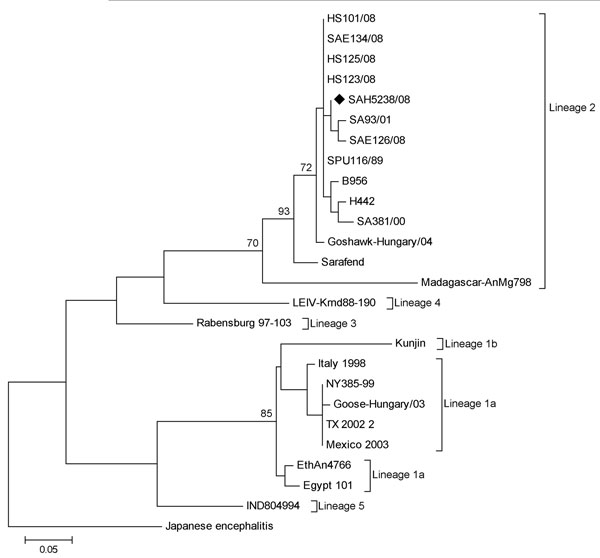Volume 18, Number 12—December 2012
Dispatch
West Nile Virus Neurologic Disease in Humans, South Africa, September 2008–May 2009
Figure

Figure. . Maximum-likelihood tree of an ≈200-bp fragment of the nonstructural 5 gene of a reverse transcription PCR–positive West Nile virus (WNV) specimen SAH5238/08 (GenBank accession no. JX974605; black diamond) isolated from a human in South Africa in 2008. The tree shows the relationship of the strain to representative sequences of 5 WNV lineages, including 5 WNV lineage 2 strains isolated from horses in South Africa in 2008 (15). The scale bar indicates nucleotide substitutions per site. Bootstrap statistics of >70% are indicated on the tree branches. WNV strains (accession numbers): B956 (AY532665), SA381/00 (EF429199), SA93/01 (EF429198), SPU116/89 (EF429197), Goshawk-Hungary/04 (DQ116961), H442 (EF429200), Sarafend (AY688948), Madagascar AnMg798 (DQ176636), HS123/08 (FJ464376), HS101/08 (FJ464378), SAE126/08 (FJ464379), SAE134/08 (FJ464380), HS125/08 (FJ464377), Rabensburg97103 (AY765264), LEIV-Krnd88-190 (AY277251), Kunjin (D00246), Egypt101 (AF260968), EthAn4766 (AY603654), Italy1998 (AF404757), Goose-Hungary/03 (DQ118127), NY385-99 (EF571854), TX2002 (DQ164205), Mexico2003 (AY660002), IND804994 (DQ256376), Japanese encephalitis ( HM228921).
References
- Asnis DS, Conetta R, Teixeira AA, Waldman G, Sampson BA. The West Nile virus outbreak of 1999 in New York: the Flushing Hospital experience. Clin Infect Dis. 2000;30:413–8 and. DOIPubMedGoogle Scholar
- Lanciotti RS, Roehrig JT, Deubel V, Smith J, Parker M, Steele K, Origin of the West Nile virus responsible for an outbreak of encephalitis in the northeastern United States. Science. 1999;286:2333–7 and. DOIPubMedGoogle Scholar
- Kulasekera VL, Kramer L, Nasci RS, Mostashari F, Cherry B, Trock SC, West Nile virus infection in mosquitoes, birds, horses, and humans, Staten Island, New York, 2000. Emerg Infect Dis. 2001;7:722–5 .DOIPubMedGoogle Scholar
- Sampathkumar P. West Nile virus: epidemiology, clinical presentation, diagnosis, and prevention. Mayo Clin Proc. 2003;78:1137–44. DOIPubMedGoogle Scholar
- McIntosh BM, Jupp PG. Epidemics of West Nile and Sindbis viruses in South Africa with Culex (Culex) univittatus Theobald as vector. S Afr J Sci. 1976;72:295–300.
- Jupp PG. The ecology of West Nile virus in South Africa and the occurrence of outbreaks in humans. Ann N Y Acad Sci. 2001;951:143–52. DOIPubMedGoogle Scholar
- Hayes EB, Sejvar JJ, Zaki SR, Lanciotti RS, Bode AV, Campbell GL. Virology, pathology, and clinical manifestations of West Nile virus disease. Emerg Infect Dis. 2005;11:1174–9. DOIPubMedGoogle Scholar
- Iwamoto M, Jernigan DB, Guasch A, Trepka MJ, Blackmore CG, Hellinger WC, Transmission of West Nile virus from an organ donor to four transplant recipients. N Engl J Med. 2003;348:2196–203. DOIPubMedGoogle Scholar
- Zaayman D, Human S, Venter M. A highly sensitive method for the detection and genotyping of West Nile virus by real-time PCR. J Virol Methods. 2009;157:155–60. DOIPubMedGoogle Scholar
- Grandien M, Forsgren M, Ehrnst A. Enteroviruses and reoviruses. 6th ed. Washington (DC): American Public Health Association; 1989.
- Venter M, Burt FJ, Blumberg L, Fickl H, Paweska J, Swanepoel R. Cytokine induction after laboratory-acquired West Nile virus infection. N Engl J Med. 2009;360:1260–2. DOIPubMedGoogle Scholar
- Tamura K, Peterson D, Peterson N, Stecher G, Nei M, Kumar S. MEGA5: Molecular Evolutionary genetics Analysis using maximum likelihood, evolutionary distance, and maximum parsimony methods. Mol Biol Evol. 2011;28:2731–9. DOIPubMedGoogle Scholar
- Lanciotti RS, Kerst AJ, Nasci RS, Godsey MS, Mitchell CJ, Savage HM, Rapid detection of West Nile virus from human clinical specimens, field-collected mosquitoes, and avian samples by a TaqMan reverse transcriptase–PCR assay. J Clin Microbiol. 2000;38:4066–71 .PubMedGoogle Scholar
- Castillo-Olivares J, Mansfield KL, Phipps LP, Johnson N, Tearle J, Fooks AR. Antibody response in horses following experimental infection with West Nile virus lineages 1 and 2. Transbound Emerg Dis. 2011;58:206–12.
- Venter M, Swanepoel R. West Nile virus lineage 2 as a cause of zoonotic neurological disease in humans and horses in southern Africa. Vector Borne Zoonotic Dis. 2010;10:659–64. DOIPubMedGoogle Scholar